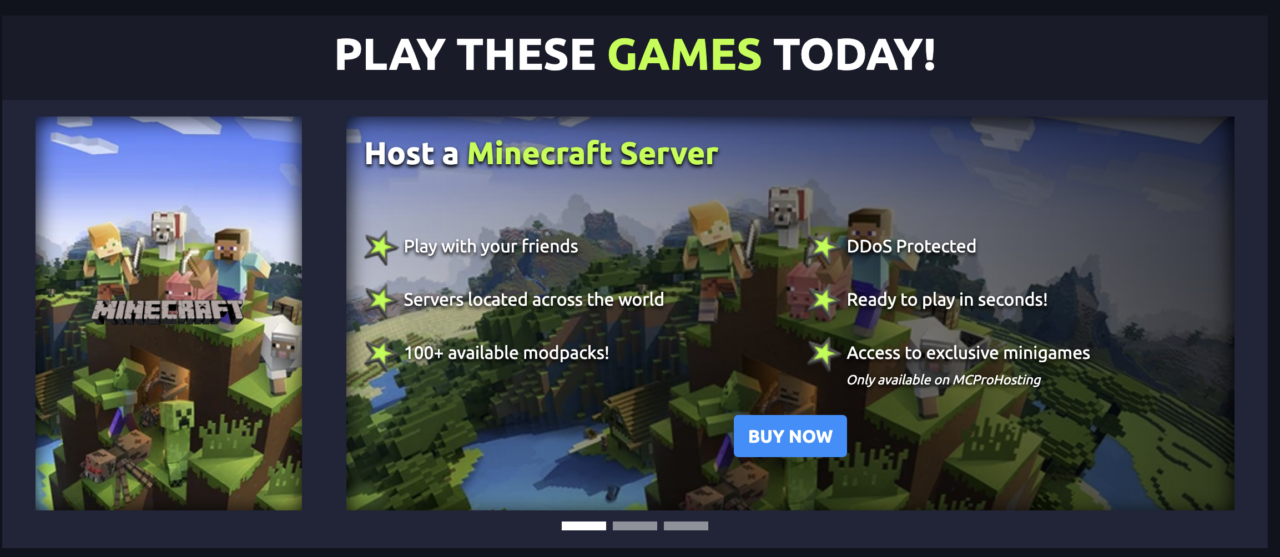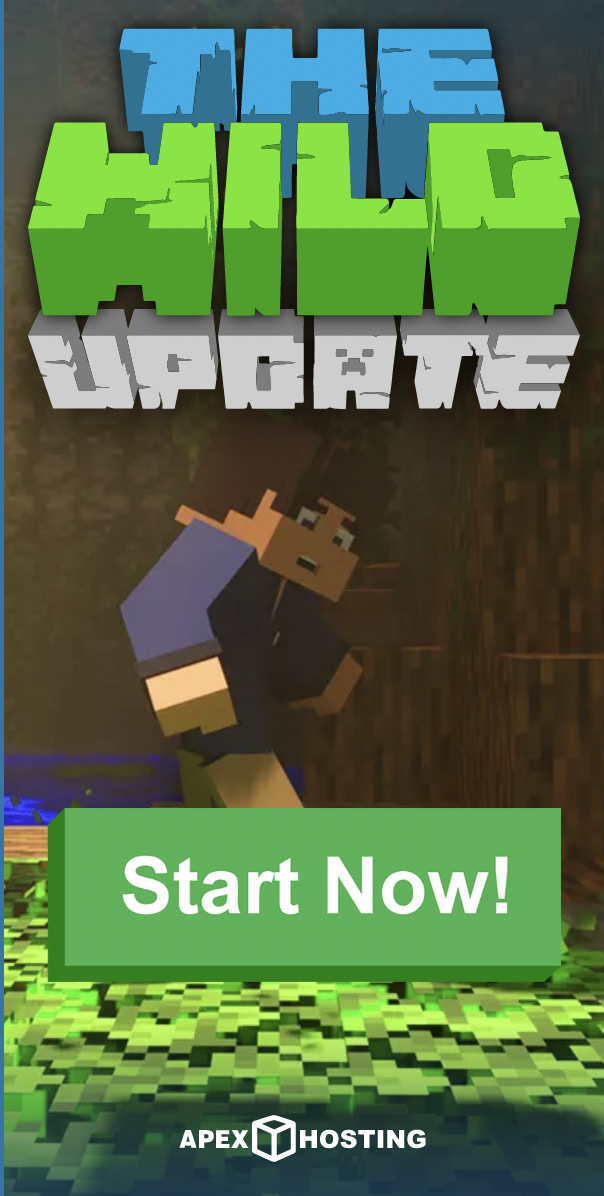Table of contents
Introduction
This new series analyzes YouTube creator marketing tactics and trends in specific industries. We look at share of voice, promotion types and other metrics to identify how much effort different companies are putting into creator marketing, what kind of creators they are working with, and where new opportunities might lie.
We look both at specific brands as well as the landscape more broadly. All data (unless otherwise stated) is from our internal analysis.
This time, we focus on game server hosting companies.
Dedicated game servers offer a reliable environment for running online games with a high workload. They are ideal for a number of games such as Minecraft, Counter Strike Global Offensive, Ark, Rust, DOTA 2, Terraria and many others. Game servers are a subcategory of server hosting, which is a massive market of over 100 billion dollars by some estimates.
Competitive landscape
The competitive landscape for game server hosting can broadly speaking be divided into two categories: general hosting providers and specialized game server providers.
General hosting providers
The general hosting providers consist of numerous providers of different sizes that are not specialized in or do not explicitly promote game server hosting services. However, their solutions can still be used to run game servers. This category includes some of the largest hosting companies such as HostGator, BlueHost, GoDaddy, and Amazon Web Services (AWS).
General hosting providers do a fair amount of creator sponsorships, but those are almost mainly focused on website hosting and similar solutions outside of gaming. Our share of voice analysis provided later in this report did find a few sponsorships done by them, but we won’t be focusing on them more than this report as the vast majority of their promotional efforts are focused on web hosting and other more general hosting services.
Specialized game server providers
The specialized game server providers typically focus on one or more game titles. While their offering is available for a broader range of titles, their public facing communications typically feature specific game titles. Minecraft is especially popular in this space and a few companies solely focus on it in their public facing comms (while still providing services for other titles as well).
In terms of value propositions, these specialist providers heavily feature gaming-focused hardware and software capabilities, as well as game-specific capabilities (especially in the case of providers focused on one or a few titles).
Other things that are often highlighted are security features (e.g. DDoS protection), fast deployment and customer support.
Screenshot examples of company websites
Example 1: Apex hosting

Example 2: Streamline Servers

There are a lot of niche players in this space, but the major providers include for example Apex Hosting, G-portal, MCProhosting, Streamline servers, Nitrado, Host Havoc, GTXGaming, ScalaCube, A2 Hosting, and Gameservers.com.
The industry has also seen some consolidation. Nitrado has acquired Apex and McProHosting, but they are still operating as their own brands.
Promotion tactics
Affiliate programs
In the influencer space, by far the most popular tactic used by game server providers is affiliate programs. Almost all of the companies have their own affiliate program that creators can sign up for.
The criteria for creators to join differ somewhat between providers, but typical criteria include having at least some thousands of subscribers (e.g. 5000+ subscribers in the case of Havoc Hosting and MCProhosting) and some thousands of views per video.
While views per video criteria can make sense (especially in terms of workload), it’s interesting that a lot of providers still set subscriber count requirements. We’ve written extensively about this in the past, but subscriber counts are actually not a good metric to use for estimating channel popularity (on YouTube and other platforms) as they do not, for example, reliably correlate with the amount of views a creator’s content gets.
The affiliate model can be an effective, low-effort solution, especially at a smaller scale, but there are also risks involved. Especially since most of the main players run these programs, there is a risk of the program becoming increasingly expensive if competitors start improving their affiliate deals. Most creators will usually take the best deal available, so if competitors increase their pricing, you will need to do so eventually as well.
Another thing advertisers need to take into account is that the promotion experience can be very inconsistent when using affiliate deals. It can be hard to set creative briefs or other creative guidance for the creators outside of them using the correct affiliate link.
While this can work well with some creators, creator marketing using creative briefs can often provide better results. As a simple example of this, instructing the creator to ask viewers to check the link in the description can significantly boost click-through and conversion rates.
Pros and cons of affiliate programs
+ Clear revenue model for both creators and the advertiser.
+ Low cost and easy to set up for an advertiser.
+ The advertiser typically only pays for the conversions that matter to them.
+ Results can be good if you get a good affiliate that consistently provides quality traffic.
– Results for advertisers might be inconsistent: some creators can bring a lot of affiliate traffic (especially if they are experienced in doing affiliate partnerships), others might not.
– The affiliate model is not attractive to all creators.
– Can be hard to use creative briefs and provide creative guidance.
– Can be time consuming to manage (depending on the setup).
– Can get expensive fast if your main competitors also run affiliate programs and you need to compete about having an attractive offering.

YouTube creator sponsorships
YouTube creator sponsorships are used to varying degrees by different companies. Approximately half of the providers analyzed do YouTube promotions, but most of these are using the affiliate model with little creative direction.
~50% of game server hosting brands consistently run creator sponsorships
For example, the creator might have a short mention of the sponsor, but dedicated sections are used rarely and the video description simply contains the affiliate link. Below are a few example videos from a few different companies.
Video 1: G-portal promotion (affiliate link in the video description)
Video 2: MCProHosting (affiliate link in video description)
As discussed above, while these tactics can work well – especially if you manage to find creators that consistently post content with your affiliate link and have good-quality content – they are not really taking full advantage of the medium
By working more closely with creators and providing them creative briefs for example, creators are often able to create even more convincing content using their unique voice. Furthermore, not all creators want to sign up for affiliate programs (especially if they are already signed up for others), or they might simply not find your program even if they were interested.
Of course, this approach can be more time consuming and resource intensive. However, partners such as MatchMade can make the process far more efficient by leveraging automation and having teams that are experts in communicating with creators so the advertiser does not need to spend excessive time on these manual tasks.
YouTube share of voice
When looking at YouTube sponsorships, it’s extremely useful to understand what each competitor’s share of voice is. Based on our data from scanning more than 11 million YouTube channels, we estimate that the share of voice in Q2 of 2022 was approximately as follows between the different game server hosting providers:
The chart below tells what percentage of the videos in each creator size is estimated to be from each advertiser. Companies with less than 1% share of voice are excluded from the table.
So for example, from the chart we can see that when it comes to creators with less than 50,000 subscribers, G-Portal has a 30% share of voice of all videos talking about game server hosting (and 49% share of voice among creators with 50,000-100,000 subscribers).

Based on these numbers, the ones with the biggest share of voice overall include G-Portal, Nitrado, Apex and McPro hosting.
Pros and cons of YouTube creator sponsorships
+ The brand can be featured in a strong and natural way when providing creators with a creative brief.
+ Partnering with creators can work very well to explain unique selling points due to the sponsorship segment lasting longer.
+ Creators are highly authentic and their message is typically very convincing to the viewers.
+ Creators have highly engaged audiences interested in the subject the creator covers so it’s easier to target people interested for example in gaming and game server hosting than with paid ads.
– Need to find a large number of creators of all sizes at the right price and need to be able to work with them efficiently at scale. However, partners such as Matchmade can make this easy for advertisers.
Paid advertising
In addition to YouTube efforts, it is also useful to briefly analyze other paid marketing efforts, namely paid advertising. The level of advertising spend is very hard to estimate on the paid side, but from our analysis we can see that many of the providers run at least some paid advertising.
- On search engines, both general (e.g. “game server hosting”) and brand keywords are targeted. Depending on the brand, this is done both for new customers and also as remarketing for people who already visited their website.
- It appears keyword targeting is not used much by these companies on YouTube. However, more generic hosting providers aggressively target any hosting -related keywords on YouTube.
- Some providers (such as Apex Hosting) also do a fair amount of display retargeting – visiting their site a few times we started seeing banner ads on multiple websites.
- On social media, Facebook and Instagram ads are used by very few advertisers. In our analysis, we only saw active ads from Apex Hosting and inMotion hosting (inMotion ads were not focused on gaming though).
Overall, it seems paid advertising is used sparingly by these companies, mainly focusing on retargeting efforts.
Most likely this could be because the product is somewhat specialized and targeting the right audience (outside of retargeting) can be difficult compared to YouTube for example.
Paid ad formats typically also make it challenging to explain the benefits of these kinds of products as the time a user spends interacting with search or display ads is typically very short.
Screenshot: Retargeting ad from Apex Hosting

Pros and cons of paid ads
+ Can be very cost effective for acquiring new customers (especially via retargeting).
+ Easiest channel to run very small budgets with.
– Prospecting might not be so effective for complex products as ad formats offer very little room for explaining unique selling points.
– Can be challenging targeting to target the right audience with niche products.
Marketing opportunities for game server companies
Based on our findings, it seems clear that there are two main opportunities.
Companies not doing any (or doing very little) creator marketing on YouTube should definitely get started. The investments made by some of the competitors clearly show that this approach is working and should be tested by the others as well. While other types of creators can work as well, a big portion of YouTube creators are in the gaming segment so they are a natural fit for game server hosting companies.
The second opportunity lies in taking full advantage of creator sponsorships. While using affiliate links and thus providing creators an easy way to generate revenue can be a good strategy (especially at a more limited scale), the best results are often reached with more deeply integrated sponsorships where the creators are provided a clear creative brief that helps them discuss the sponsor and their offering in further detail.
This lets advertisers leverage creators’ unique styles – which are one of the main reasons people watch their videos – far more effectively. It also takes far better advantage of the visual, longer-form medium that YouTube creators offer.
In conclusion
We hope you have found this report useful! If you have any further questions about the contents or would like to learn more how we help advertisers work with YouTube creators of all sizes efficiently, cost-effectively, and at scale, get in touch





